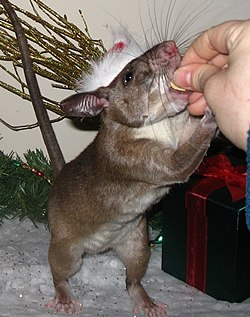Emin's pouched rat
| Emin's pouched rat | |
|---|---|

| |
| Scientific classification | |
| Kingdom: | |
| Phylum: | |
| Class: | |
| Order: | |
| Superfamily: | |
| Family: | |
| Subfamily: | |
| Genus: | |
| Species: | C. emini
|
| Binomial name | |
| Cricetomys emini Wroughton, 1910
| |
Emin's pouched rat (Cricetomys emini), also known as the African pouched rat, is a large rat of the muroid superfamily. It is related to Cricetomys gambianus, the Gambian pouched rat.
They are native to Africa and are found along the edges of forests and along the plains. Emin's rats are actually better climbers than their better known Gambian pouched rat cousins. These pouched rats are named for having cheek pouches much like a hamster.
Emin's rat and the Gambian rat have a few very noticeable physical differences:
- Emin's rat has a distinct line of color difference between their lower abdomen area and upper body. The abdomen is grey/white, whereas their upper body is dark brown. The tail has a white tip to it. Gambian rats have a greyish-brown color that is fairly uniform throughout their body, only gradually getting lighter on their abdomen.
- Emin's rats are very sleek and muscular in appearance. They're quite slender looking, and are excellent climbers. Gambians are somewhat bulky, rough looking, and have been reported to be less "arboreal" than the emin's.
- Emin's rats tend to weigh less and be slightly smaller than the Gambian rat.
Both species were introduced into the exotic pet trade. Unfortunately, many dealers and breeders failed to recognize the difference in the two species and some even tried breeding the two together. There have been reports of it being successful, and other reports of offspring dying at birth. Both species are sometimes kept as pets, but males can be territorial to others of the same species.
References
- Template:IUCN2006 Database entry includes a brief justification of why this species is of least concern

